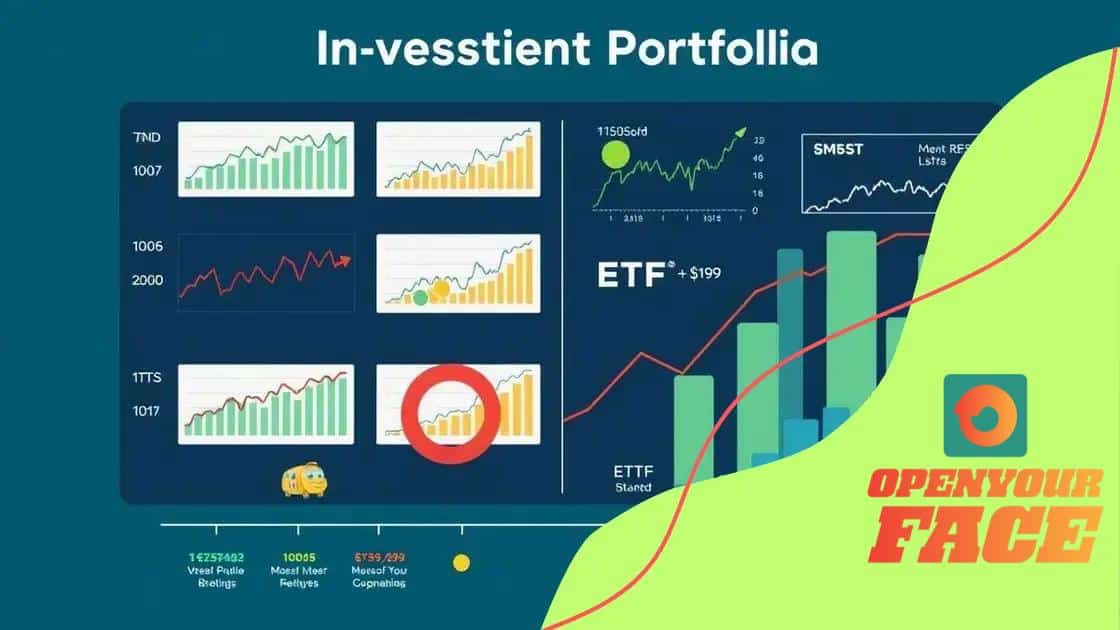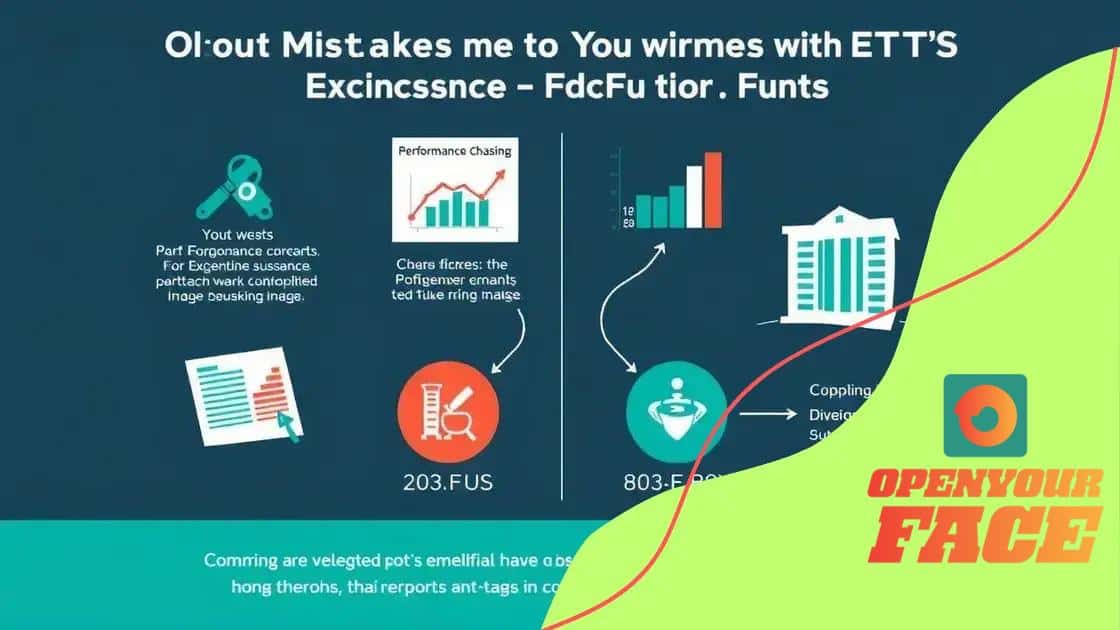The role of ETFs in a balanced investment portfolio

The role of ETFs in a balanced investment portfolio is to provide diversification, cost efficiency, and access to various markets, making them essential tools for effective investing.
The role of ETFs in a balanced investment portfolio can’t be underestimated. They offer flexibility and diversification, making them an appealing choice for many investors. But what exactly makes them so essential in today’s market?
Understanding ETFs and their purpose
Understanding ETFs is essential for modern investors. These financial instruments, known as Exchange-Traded Funds, combine the features of mutual funds and individual stocks. They offer a unique way to invest in a wide range of assets without the complexity of managing each individual investment.
What are ETFs?
ETFs are funds that trade on stock exchanges, similar to stocks. They hold a collection of assets, such as stocks, bonds, or commodities, and are designed to track the performance of a specific index or sector. This makes them an appealing option for those looking to diversify their portfolios efficiently.
Benefits of ETFs
Why should you consider including ETFs in your investment strategy? Here are some key advantages:
- Cost-effective: ETFs typically have lower expense ratios compared to mutual funds.
- Liquidity: Since they are traded on exchanges, ETFs can be bought or sold anytime during market hours.
- Diversification: Investing in an ETF allows you to gain exposure to multiple assets, reducing risk.
- Transparency: Most ETFs regularly disclose their holdings, allowing investors to see where their money is going.
Another significant aspect of ETFs is their tax efficiency. Unlike mutual funds, which may trigger capital gains distributions, ETFs minimize this impact due to their unique structure. Additionally, investors can buy and sell ETFs throughout the trading day, providing flexibility in managing investments.
Understanding how ETFs work also means grasping the concept of tracking an index. For instance, an ETF may aim to replicate the performance of the S&P 500 by holding the same stocks in similar proportions. This allows investors to participate in the broader market’s movements without selecting individual stocks.
As interest in ETFs continues to grow, it’s crucial to stay informed about potential risks as well. Although they offer many benefits, not all ETFs are created equal. It’s essential to examine the fund’s goals, underlying assets, and performance history before investing. In conclusion, ETFs serve as powerful tools for diversifying and balancing investment portfolios, providing unique opportunities and flexibility for both novice and experienced investors.
Benefits of including ETFs in your portfolio

Investing in ETFs offers several benefits that can enhance your investment portfolio. By including these funds, you can achieve a diverse mix of assets without the need for extensive research on individual stocks or bonds. This simplicity makes ETFs a popular choice for both new and experienced investors.
Cost Efficiency
One of the most compelling reasons to add ETFs to your portfolio is their cost efficiency. Typically, they have lower management fees compared to traditional mutual funds. This can significantly save you money over time, especially if you are investing for the long term.
Diversification Made Easy
ETFs allow you to invest in a collection of assets, which means you can spread your risk across various sectors without purchasing multiple stocks. This diversification reduces the impact of any single investment’s poor performance on your overall portfolio.
- Reduced risk: Spreading investments across different sectors allows for greater stability.
- Access to various markets: ETFs can give you exposure to international markets and niche sectors.
- Variety of options: With numerous ETFs available, you can choose funds that align with your investment goals.
Moreover, ETFs are incredibly flexible. They can be bought and sold throughout the trading day, just like stocks. This liquidity allows investors to react quickly to market changes, making it a more responsive investment option.
Tax efficiency is another advantage of ETFs. These funds usually generate fewer capital gains distributions than mutual funds, meaning you keep more of your investment profits. Because of this, they are often viewed as a more tax-friendly choice for investors.
Lastly, the transparency of ETFs is worth noting. Most funds are required to disclose their holdings regularly, allowing you to know exactly where your money is invested. This feature supports informed investment decisions and helps build trust between investors and fund managers.
How to choose the right ETFs
Choosing the right ETFs for your investment portfolio is crucial for achieving your financial goals. With numerous options available, it’s essential to understand a few key factors to make informed decisions.
Define Your Investment Goals
Before selecting ETFs, start by clearly defining your investment objectives. Are you looking for growth, income, or a balance of both? Understanding your goals will guide your choice of funds. For instance, if you’re targeting long-term growth, you might consider ETFs that focus on high-growth sectors like technology.
Consider Expense Ratios
Another important aspect to look at is the expense ratio of an ETF. This fee impacts your overall returns, so lower expense ratios can lead to better performance over time. Comparing the costs of various funds can help you maximize your investment.
- Low-cost options: Look for ETFs with expense ratios below 0.2% for greater profitability.
- Check historical performance: Review how the ETF has performed against its index over time.
- Review liquidity: Ensure the ETF has a healthy trading volume to avoid wide price spreads.
Additionally, examining the underlying assets of the ETFs you’re considering is essential. Ensure the fund aligns with your risk tolerance and investment strategy. For example, if you’re conservative, look for ETFs that include bonds or established companies.
Furthermore, it’s wise to explore the fund manager’s reputation and experience. Well-managed ETFs often lead to better tracking of their indexes, making a significant difference in your investment success. Researching the provider’s history can offer insights into their reliability in managing funds.
Finally, reviewing the tax implications of ETFs is important. Some funds may generate higher capital gains distributions, impacting your tax situation. Consider ETFs that are more tax-efficient to keep your returns intact.
Common mistakes to avoid with ETFs

Investors looking to include ETFs in their portfolios may make several common mistakes that can hinder their financial success. Being aware of these pitfalls can help you invest more effectively.
Chasing Performance
One major mistake is chasing past performance. Many investors see an ETF that has recently performed well and rush to invest, hoping for similar results. However, past performance does not guarantee future returns. It is essential to consider the underlying fundamentals of the fund rather than just its recent gains.
Ignoring Fees
Fees can significantly impact your investment returns. Some investors overlook the expense ratios of ETFs when making their choices. High fees can eat into your profits over time, making it important to compare costs carefully.
- Evaluate historical expense ratios: Look at the fees of different funds.
- Avoid hidden fees: Some ETFs may have additional costs that are not immediately clear.
- Keep fees low: Aim for ETFs with lower expense ratios to maximize profits.
Another mistake is failing to diversify within your ETF investments. Investing in only one or two ETFs can expose you to higher risks. It is vital to create a diversified portfolio that includes various sectors and asset types to balance risk and return effectively.
Not understanding the ETF structure is also a common issue. Some investors are unaware of how ETFs operate, which can lead to misconceptions about their risks. For instance, ETFs that track volatile sectors may exhibit price fluctuations that could surprise investors unfamiliar with their behavior.
Additionally, neglecting tax implications can be detrimental. While ETFs are generally tax-efficient, they can still generate capital gains. Investors should understand the potential tax responsibilities associated with their ETF investments.
Future trends in ETF investing
The future of ETF investing looks promising as the financial landscape evolves. With technology playing a pivotal role, investors can expect exciting trends shaping how they invest in these funds.
Growth of Thematic ETFs
One notable trend is the rise of thematic ETFs. These funds focus on specific trends or sectors, such as green energy or technology innovation. By targeting burgeoning areas, investors can align their portfolios with their values and interests. Thematic ETFs often appeal to younger investors who seek growth opportunities in sectors they believe will thrive in the future.
Increased Use of Artificial Intelligence
Also, artificial intelligence (AI) is beginning to play a larger role in ETF management. Fund managers are utilizing AI to analyze vast amounts of data, helping them make better investment decisions. This technology can improve efficiency and lead to more adaptive strategies as market conditions change.
- Enhanced data analysis: AI can process data more quickly than humans, providing real-time insights.
- Better risk management: Using machine learning algorithms helps predict market movements.
- Dynamic portfolio adjustments: AI enables faster responses to changing market conditions.
Another trend is the focus on sustainable investing. Many investors are becoming more conscious of how their money impacts the environment and society. As a result, ETFs focusing on socially responsible investments are gaining traction. These funds allow investors to support companies that prioritize sustainability while potentially enjoying financial returns.
Moreover, many financial institutions are launching more low-cost and niche ETFs. This helps accommodate various investment strategies and preferences. Investors can access broader asset classes, including international and alternative investments, with lower fees.
Finally, regulatory changes are expected to influence the ETF market. The ongoing discussions around regulations may lead to increased oversight, benefiting investors by ensuring better transparency and reduced risks.
FAQ – Frequently Asked Questions about ETFs in Investment Portfolios
What are ETFs?
ETFs, or Exchange-Traded Funds, are investment funds that trade on stock exchanges, holding a collection of assets like stocks or bonds.
Why should I include ETFs in my portfolio?
Including ETFs can help you achieve diversification, cost efficiency, and access to various market sectors.
What common mistakes should I avoid when investing in ETFs?
Common mistakes include chasing past performance, ignoring fees, and failing to diversify your investments.
How can I stay informed about future trends in ETFs?
Following financial news, reading investment analyses, and exploring online resources can help you stay updated on ETF trends.






